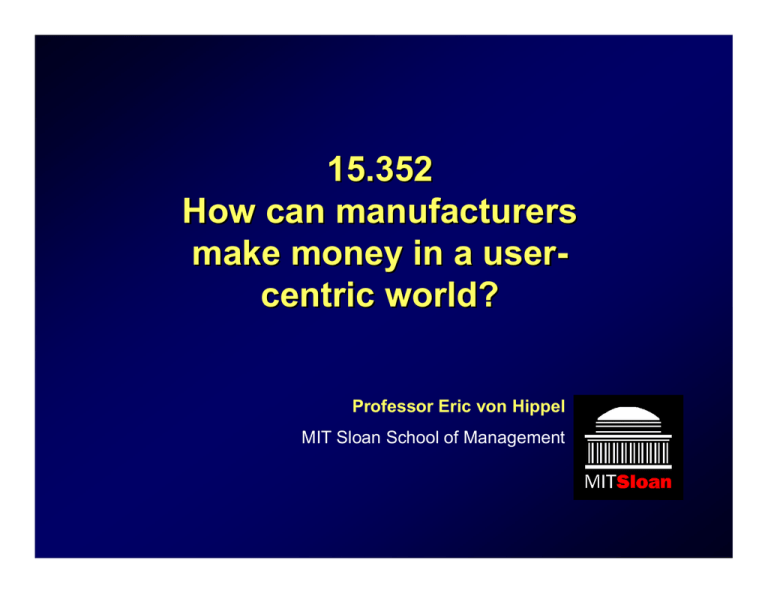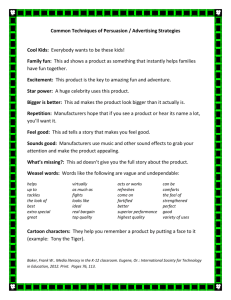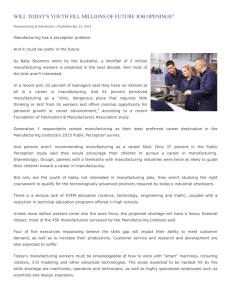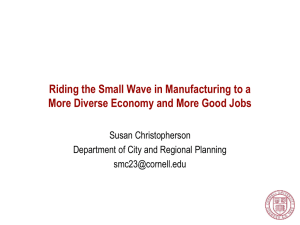15.352 How can manufacturers make money in a user -
advertisement

15.352 How can manufacturers make money in a usercentric world? Professor Eric von Hippel MIT Sloan School of Management How can manufacturers make money Competing with user innovation? Individual lead user innovates Lead user communities dominate Lead user communities and manufacturers viable # of users perceiving need Time Time User innovation communities can supplant product development by manufacturers EXAMPLE: Zeroprestige.org “We are interested in furthering kite-powered sport by enabling an 'open source' (shared knowledge and documentation) approach to kite-building and things kite-powered in general.” “You are encouraged to post and add comments and knowledge to any of the postings.” Users develop and post kite designs - often better than designs by kite manufacturers EXAMPLE: Super high AR mountain board kite “From Sebastian in Argentina.. a super high AR inflatable design for mountain boarding…” Posted by saul at 05:58 PM RESULT: User Innovation Communities may drive kite manufacturers right out of product design – but not manufacturing z HAS BEEN An industry of manufacturers that develop and sell kites of their own design. z $100mm in equipment sales in 2002 – growing fast. z TODAY – some firms are moving to a “build only” specialization – leaving product innovation to the user community (Firms are starting to download and build user designs instead of creating their own kite designs.) There are many ways for manufacturers to associate with / benefit from user innovation communities Manufacturers can: z Sell users access to a platform for innovation – Stata (statistical software language and toolkit) – Harley Davidson (customization-friendly motorcycles) z Sell user innovations as commercial products – Red Hat (sells Linux with easy installation features) – Lead user studies find user innovations to commercialize z Sell products that complement user innovations – IBM sells computer server hardware that mounts Linux Often there IS an opportunity for manufacturers to benefit from user innovation communities Manufacturers can: 1. Aid users in tailoring standard product offerings for themselves Example – Harley Davidson Example – toolkits - Statacorp 2. Take back learning about user-developed innovations to their standard offerings Example – StataCorp 3. Supply complements Example – Red Hat Statacorp has learned to integrate user-developed innovations into its commercial product on a regular basis Self-organized user community innovates - STATA integrates best efforts Key elements Self organized user community High technical incentive for users to innovate on core product Integrate Create new modules User modules Attach Core Product Stata New releases Users determine lending features Stata does QC and Lode rewrite integrates into core User community Full acknowledgement of user innovators Significant Significant portion portion of of STATA STATA product product based based on on user user ideas ideas User-made map editor for Westwood Studios’ Game Red Alert 2 On-line game firms use consumer-to-consumer support to reduce their own product support costs Example: Westwood Studios: •Consumer-to-consumer support is ~13 times the Westwood official game toolkit support. •The highest-quality support is provided by just a few users: •6 of the most active consumers each provide as much support as the entire Westwood contribution Source: Lars Bo Jeppesen GE MRI Lead User Innovation strategy elements • Establish Research Relationships with Key Luminaries and Institutions which give GE access to innovations they develop. • Give users development tools • Co-Locate Engineers and Scientists to Develop Clinically Relevant Breakthrough Technology Provide Provide Development Development Toolkits Toolkits to to Enable Enable Clinical Clinical Innovation Innovation MR Application Studio App Development Environment De-Centralize GE Applied Science Lab to colocate with lead user innovators z Co-locate Engineering / Application Teams at Luminary Sites – Hire Industry-Best MR Talent z Build Talent Pipeline z Gain Expertise in Emerging Applications z First to market with Clinically Driven Applications z Multi-site Testing in Research Community The interests of a user innovation community and a “host” firm may be aligned – or may not be. “Complete Alignment” Increasing utility to manufacturers “Completely Orthogonal” Utility not applying to manufacturers “Completely Negative” Source – Ethan Mollick Automakers can find themselves at odds with some members of “their” user innovation communities Users reprogram / replace their auto engine chips to get higher performance – Manufacturers worry about consequent warrantee costs NYTimes, February 12, 2004 Policy Implications User-centered innovation is increasing as computing and communication costs drop. z User-centered innovation increases social welfare. Should be supported by – or at least not discriminated against – by policy. – IP is being used in ways that favor major holders (e.g., patent thickets) Since user-innovation is distributed, each innovator will have little IP – is at a disadvantage. – Digital Millennium Copyright Act is aimed at illegal copying – but also causes collateral damage to user innovation. Affects users’ ability to modify and improve what they buy.


